Why Do I Only Slice With My Driver and Not My Irons? [2024 Guide]
Struggling to hit a nice controlled ball flight with your driver but not your irons? This maddening inconsistency plagues countless golfers, ruining scores and causing frustration on the golf course. In this guide, I’ll explain why drivers act differently from your irons and the key to eliminating these destructive slices.
Why Am I Slicing My Driver But Not Irons?
My amateur golfers tend to hit a slice ball flight with their driver much more than with their irons. Todd Kolb, a PGA Certified Instructor with over 30 years of experience, explains that you slice with your driver because
“The driver has the least amount of loft, it is the longest club in your bag, and it is the one club where the ball is on a tee every time. It is also the one club where the objective is to hit up on the ball. When you combine all these factors, it is by far the club golfers slice the most.”
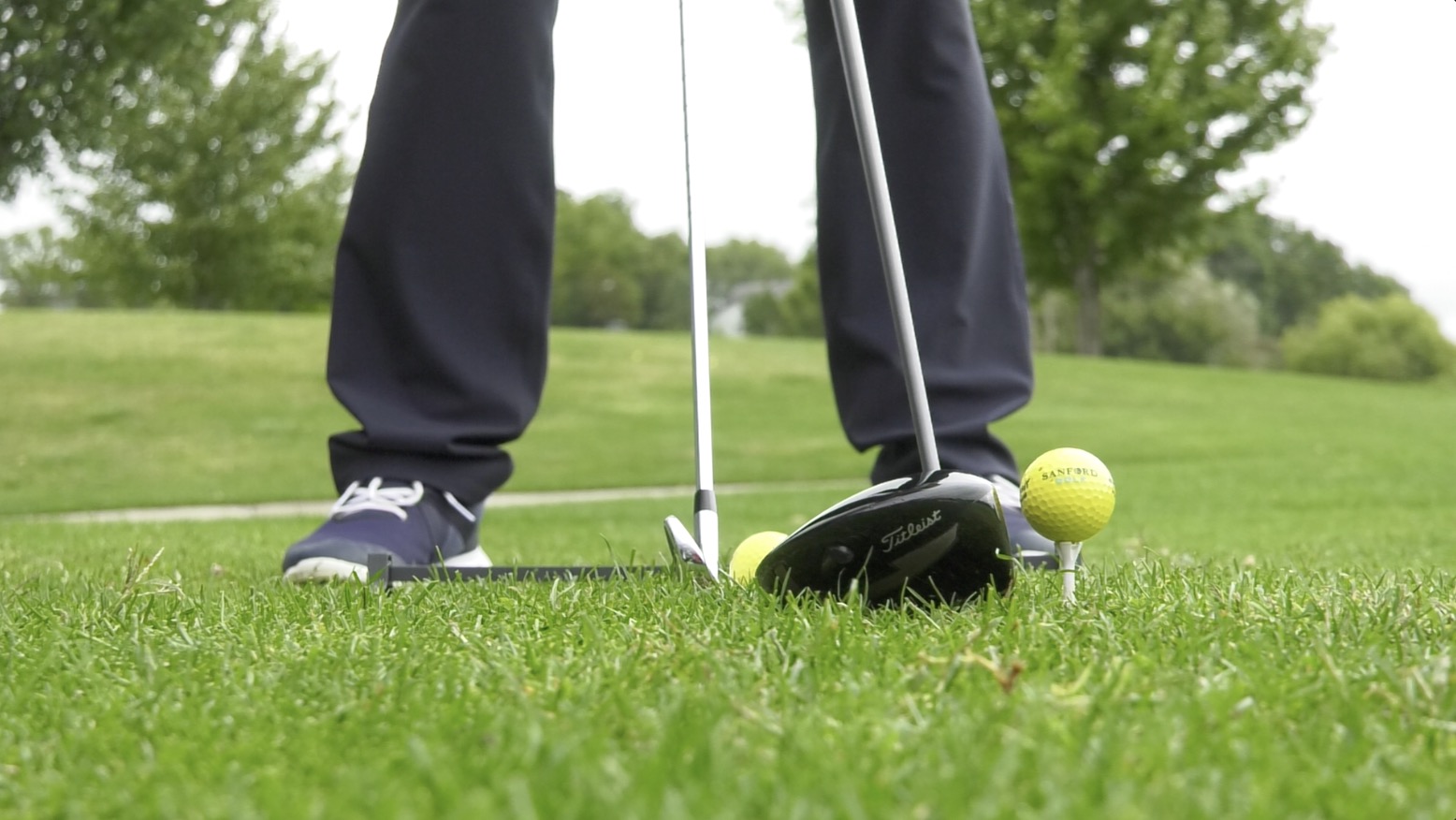
Understanding and adjusting for these differences is the key to not hitting a slice with a driver.
Sadly, I hear this frustration from the average golfer all the time. They’re out on the course hitting beautiful, high shots with their irons, but when they step up to the tee box with their driver, they end up slicing the golf ball right into the rough, OB, and hazards
Here are a few differences between driver and iron swings to begin your learning.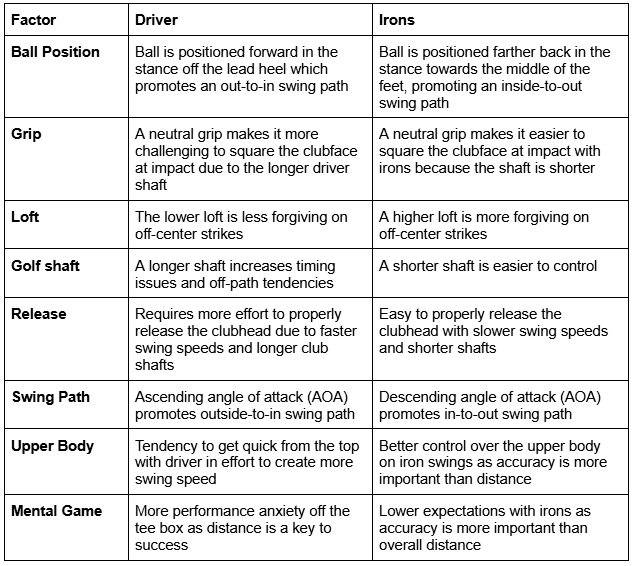
Why Do I Only Slice With My Driver and Not My Irons?
Do you often wonder: Why do I slice with a driver but not my irons? Is it in the grip? The swing? Do I need to replace my driver?
Kolb shares that irons are easier to hit straight since they “are some of the shortest and most lofted clubs in your bag, and when struck correctly, the club is traveling in a downward motion. All of these factors combined promote a swing direction that is more in-to-out, making it easier to hit a nice draw ball flight.”
You can’t use the same swing for both your irons and your driver. Those two types of clubs are designed differently, with different shaft lengths and different lofts. They are made to achieve different goals.
One of the biggest mistakes the average golfer can make is assuming that their best iron swing should also be the best golf swing for their driver. It is not. You have a different goal for your irons than your driver. With irons, the primary goal is accuracy, whereas with the driver, the primary goal is distance.
It is true that with both irons and your driver, you want to hit the ball in the sweet spot of the club, as this will produce proper distance and accuracy for all clubs. However, you do this with an iron by hitting down on the golf ball. The opposite is true of your driver, where you want to catch the ball on an ascending motion.
I like to use the analogy of an airplane. When hitting an iron, the clubhead is like the airplane coming in for a landing. When hitting a driver, the clubhead is like the airplane during takeoff.
It is important to understand that these differences affect your swing path, which has a huge impact on whether—and how much—the ball curves. You’re going to have trouble with one or the other if you don’t account for that and instead use the exact same golf swing for both shots. Sadly, this is why one of the most common complaints throughout the history of golf is, “I always slice with my driver!”
Reasons You Slice Your Driver and Not Your Irons
If you’re struggling with slicing your driver but don’t experience this issue with your irons, here are some reasons why that’s happening:
Incorrect Ball Position
The ball position for an iron swing and a driver swing should not be the same. When hitting a driver, take a wider stance and position the ball straight out from your lead heel. Unfortunately, many golfers make the mistake of playing the ball in the middle of their stance for both their irons and their driver.
This centered ball position doesn’t allow enough time to release the clubhead, resulting in an open clubface at impact and producing a low slicing ball flight.
Wrong Grip
A common golf grip issue causing a slice ball flight with the driver is having your lead hand (for right-handed golfers, this is the left hand) turned too far towards the target. I’ve seen this position among many amateur golfers who struggle with their driver.
Generally speaking, a weak lead hand grip makes it more difficult to control and return the clubface back to a square position. Now, like most things in golf, there are always some exceptions, but by and large, the following three statements are a good reference for you:
- An overly weak grip leaves the clubface open through impact, resulting in slices.
- A strong grip can help prompt a draw; however, be careful as it can quickly turn into a low hook.
- A neutral grip encourages a straight shot for better workability.
In a nutshell, you should maintain a neutral grip position as it is best for the long term. If you do tend to hit a slice with your driver, try to avoid an overly weak lead hand grip.
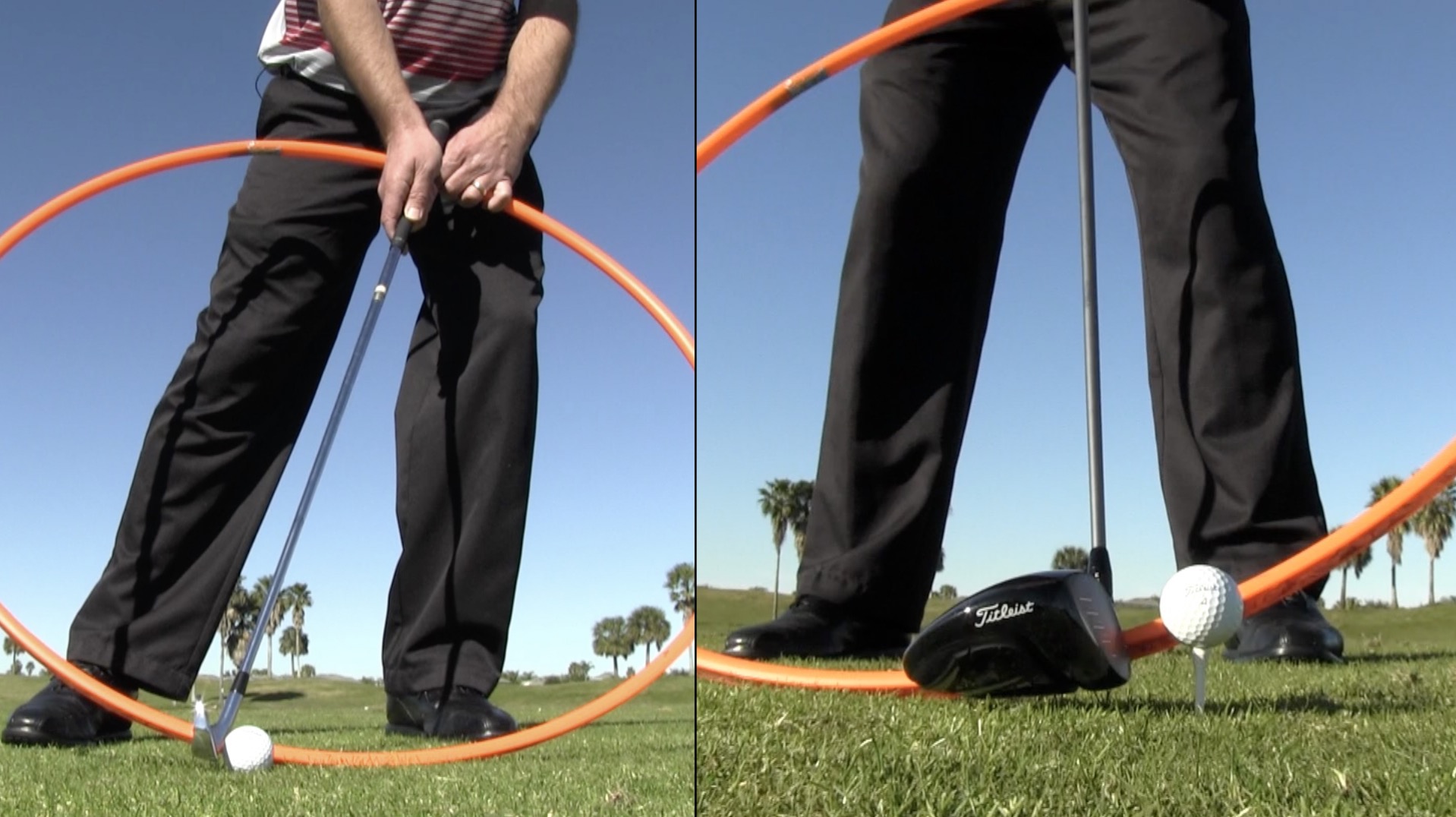
Weaker Lofts or Driver Loft Changes
Of all the golf clubs in your bag the driver will have the least amount of loft. This is important to know because the lower the loft, the more challenging it is for a golfer to achieve a controlled, straight ball flight.
Now, some drivers come with the flexibility to add loft to the club by adjusting the weighting in the clubhead or the shaft position. If you are struggling with a slice ball flight with the driver, it is better to add loft as it will make it easier to control the ball’s flight.
As a comparison, your irons will have much more loft than your driver. This additional loft provides forgiveness on off-center strikes and makes it much easier to control the golf ball.
Note that a low-lofted driver paired with a slow swing speed will produce a low ball flight, a real lack of distance, and make it very challenging to hit a desired nice high draw ball flight.
Shorter or Wrong Golf Shaft Flex
So many golfers forget that using the proper golf shaft flex can prevent slices. The longer driver shaft may require a different flex than your iron shafts. Longer driver shafts lead to increased clubhead and swing speed at impact. However, they make it more difficult to square the clubface at impact, resulting in a slice ball flight.
Amateur golfers often have an easier time controlling shorter iron shafts and may benefit from a shorter shaft in their driver. I recommend getting professionally fit so you can identify if the wrong shaft flex is causing your slice issues.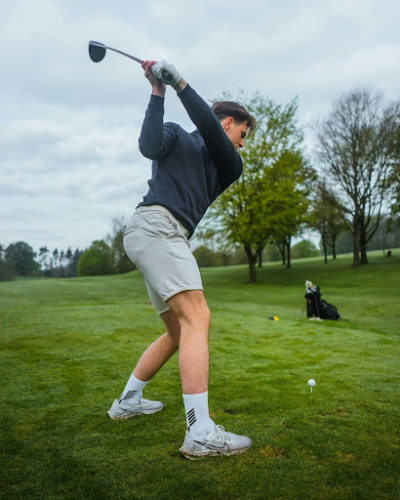
Late Release
Some golfers struggle with properly releasing the driver due to the longer shaft length, while others try to swing too hard and “kill” the ball. Keep in mind that a late release (getting the clubface back to square) can create a slice ball flight.
For many golfers, releasing the golf club is not an issue with a neutral grip on shorter clubs like irons. During training, practice alternating driver and iron swings to feel the difference between the clubs. By alternating back and forth (iron, driver, iron, driver) you can start to blend to two feels and improve your driving over time.
Steep Golf Swing Path
The iron swing path is naturally steeper than the driver swing path due to the length differences between golf clubs. Ideally, we want a shallower swing path with a driver because it promotes a longer, more penetrating ball flight. This is also true because the driver is the only club you hit where the golf ball is on a tee elevated off the ground.
You’ll also notice that the ball position is forward in the stance promoting an upward attack angle (remember the airplane analogy). The upward angle of attack (AOA) is ideal for more carry and roll resulting in more distance.
Active Upper Body
In a golf swing, the key move that separates great ball strikers from those who struggle with contact and a slice ball flight is the first move in the downswing. This is referred to as the “transition” and is one of the most important moments in the golf swing.
In a good transition, the first move is a slight bump of the lead hip towards the target. This move resets the weight onto the lead foot and allows the upper body to drop or slightly tilt back and under. It is this tilt that allows the club to drop to the inside and creates an in-to-out swing path.
Most slicers of the golf ball do just the opposite. They initiate the downswing with their upper body, first causing the club to work out and steep, resulting in an out-to-in swing path. Many times this is the result of an incorrect backswing plane or a lack of flexibility in the body.
Mental Game
Whether you’re an amateur or professional golfer, your mental thought process will play a role in the quality of shots you are able to hit. The first objective should be hitting straight shots over pure distance.
Swinging aggressively while sacrificing fundamentals often leads to poor shots, including a slice ball flight with the driver. Professional golfers and instructors prioritize control and consistency before attempting to maximize power.
Don’t let the desire to max out distance negatively impact your fundamentals for keeping the ball straight and in play. With your driver, focus first on making solid contact and hitting your intended target line. Once you’re consistently hitting it straight, then work on adding clubhead and ball speed.
Why Do My Iron Shots Go Straight But I Slice with My Driver?
Earlier we discussed how the goal with your irons is to hit slightly down on the golf ball at impact. This downward movement of the clubhead helps create an in-to-out swing direction.
On the flip side, when we swing the driver, we want to come in contact with the ball as the golf club is moving in a slight upward motion. This upward movement increases distance, assuming we strike the ball in the center of the face.
Let’s dive a little deeper into this topic of the clubhead moving down or up in the golf swing.
The Hula Hoop
Imagine the path of your club head like a hula hoop. Now, when you take your golf swing, you don’t keep your club shaft perfectly vertical, right? It has a natural lean to accommodate the distance between your golf ball and your hands.
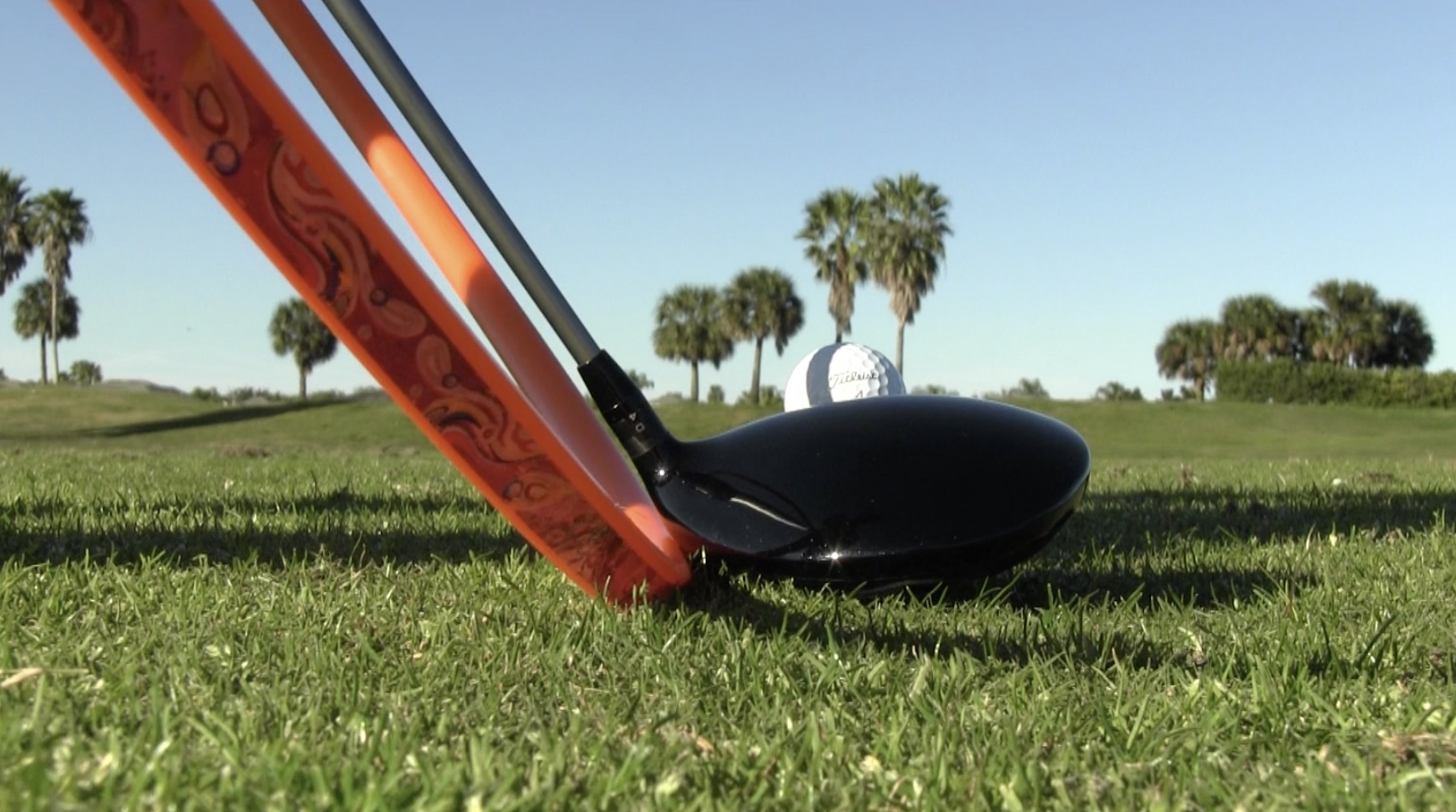
As a visual, imagine a hula hoop tilted at a slight angle towards your body yet still square to the target line. Now, depending on where you are on the hula hoop, you could be traveling down or up along the circle.
When you are traveling down, you are also naturally traveling to the right of the target line. When you are traveling up the hula hoop, you are naturally traveling to the left of the target line. The same movement is true for the clubhead in the golf swing.
When you swing your iron and hit the ball solidly, the clubhead comes in contact with the ball before it hits the ground. This means your club head is moving down the circle (hula hoop) and therefore traveling to the right of the target. This is what is referred to as a downward angle of attack (AOA), which helps promote an in-to-out swing path, making it easier to hit a draw ball flight.
But your driver is different. With your driver, you hit the ball after the low point, when the club head starts traveling up the circle and therefore to the left (if you’re right-handed) of the target line. This impact position where the clubhead is traveling up and to the left promotes an in-to-out swing path, resulting in a slice ball flight.
This is why you have a much easier time hitting straight golf shots with your irons and why you have to adjust for your driver.
Challenges with Hybrid Clubs
While many golfers notice a pronounced slice primarily with their drivers, Erin Blakely, the Founder of Senior Golf Source, explains that it’s not uncommon for these issues to extend to other clubs in the bag, particularly hybrid clubs such as the 3 hybrid or 4 hybrid. Hybrid clubs are often designed to bridge the gap between fairway woods and long irons, providing the distance of a wood with the control of an iron.
However, in terms of design, hybrids share some characteristics with drivers, such as a lower center of gravity and sometimes a longer shaft length than traditional irons. These design features can result in the same swing faults that cause slices with the driver.
Swing Path and Face Angle
Slices are typically the result of an outside-to-inside swing path coupled with an open clubface at impact relative to the swing path. Assuming center-of-the-face contact, this combination imparts a left-to-right spin on the ball for right-handed golfers, causing it to veer off to the right.
The Importance of Consistency
Golfers often practice extensively with their irons, leading to a more reliable and consistent swing with these golf clubs. However, drivers and hybrids are sometimes neglected during practice sessions. The inconsistency in practice can lead to less familiarity and control, making it easier to revert to poor swing habits that cause a slice.
How to Fix a Golf Slice With a Driver
You can do a deep dive, uncovering all the secrets of why you struggle with hitting a slice and look for ideas and or drills to fix your mistakes. As a golf coach, I’m all about this option because I think this is one of the reasons we love golf. It is fascinating to learn, and finding drills that work for us is part of the journey we enjoy.
I highly recommend checking out some of my other articles on fixing the slice. You can also download my free ebook, Science of the Slice. This book covers everything you could ever want to know about why you slice the ball and how to fix this problem.
For now, just know that if you’re constantly slicing your driver, the solution can be found with a little research and understanding. The solution is available, we just need to find it.
Key Swing Checks to Fix a Golf Slice
Again, there are a lot of aspects of your swing to consider when you’re trying to fix the slice. For now, let’s take a close look at your driver setup.
- Now, if you can swing it, I recommend using a LiveView camera to work on issues like this. The LiveView provides live, mirror-image video of your golf swing.
- You can watch the video on any smart device and even draw coaching objects on the screen. This helps you check for alignment in your hands and hips, while also helping you improve your swing plane.
- Check your setup by drawing two vertical lines: one that passes through the ball up towards the lead ear and one just outside the lead hip. (If you don’t have a LiveView camera, just visualizing these lines can help.)
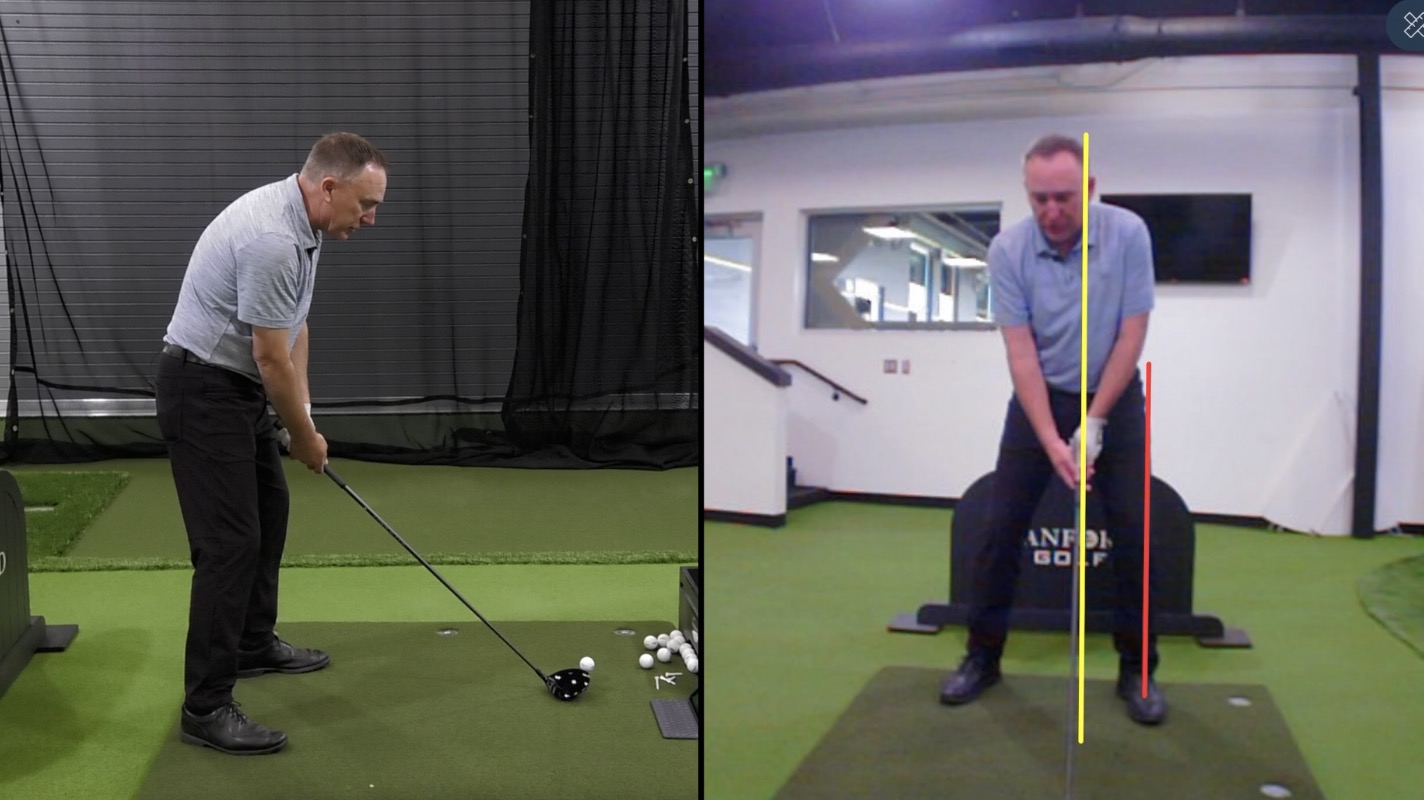
Now, what checkpoints are we looking for in the setup?
Setup Checkpoints
As you take your setup, we’re going to look at three elements::
- Where is your lead hip?
- How are you establishing aim with your feet?
- Where is the clubhead?
I’ll walk you through each of these checkpoints one by one, keeping it simple so you don’t get bogged down in the physics of golf. First, let me lay the groundwork for why these checkpoints matter. The better you can understand this, the easier it is to adapt.
Setup Tips for Straighter Drives
Ready to stop asking, “Why do I only slice my driver and not my irons?” Try these three easy tips listed below. If you want ideas on how to improve contact with your irons, check out this article on hitting it flush with your irons every single time.
The next time you set up to hit your driver:
- Bump your lead hip toward the target and keep your head back.
- Aim your stance slightly to the right (left if you’re left-handed).
- Hover your clubhead behind the golf ball.
Let’s dive a little deeper into these elements and take a look at them one by one.
Body Position
At the moment of impact, you want your lower body to move forward (toward the target) and your upper body to lean slightly away from the target. Think about bumping your lead hip forward and keeping your head back. This body position will help move the club “underneath” or what we call “into the slot”. This is the desired club shaft position to hit a nice high draw.
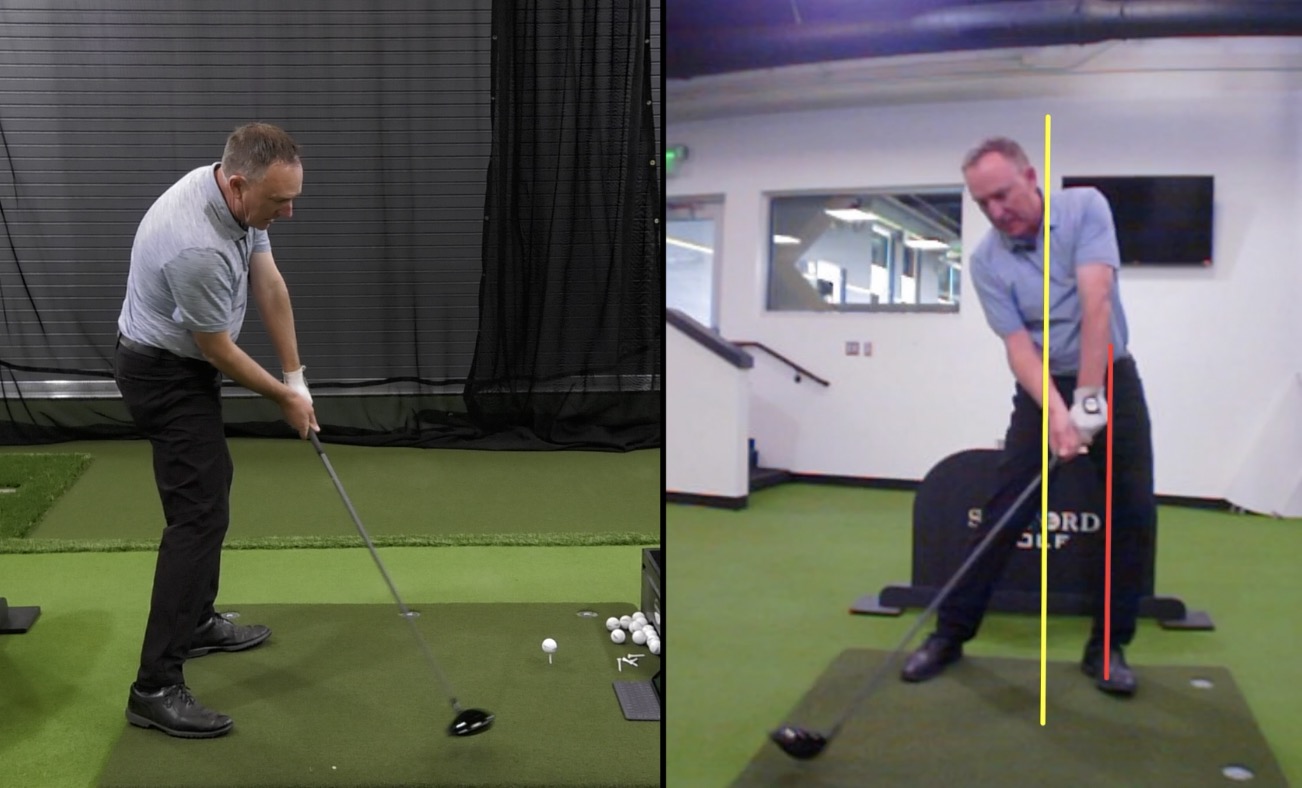
This also puts you in the right position to hit up on the golf ball so you get the height and distance you want for a long, high draw.
Now, the best way to make sure you find that position at the moment of impact is to find a similar position at setup. As you settle in at the tee:
Bump your lead hip over the lead foot. If you have a LiveView, check to make sure:
- Your trail hip is inside the trail foot.
- Your lead hip is over the lead foot.
- Keep your head slightly back and titled a little away from the target.
When you start from this position, the natural momentum of your backswing and downswing brings you back to a similar position at impact.
Golf Ball Position and Aim
This is where we address that pesky hula hoop problem and the concept of the driver working up the circle.
When you’re a right-handed golfer, you want a slight rightward (closed) aim at address with your feet, hips, and shoulders. This little adjustment will help offset the movement of the clubhead working up the hula hoop as we discussed earlier. If you’re left-handed, you want a slight leftward (closed) aim bias.
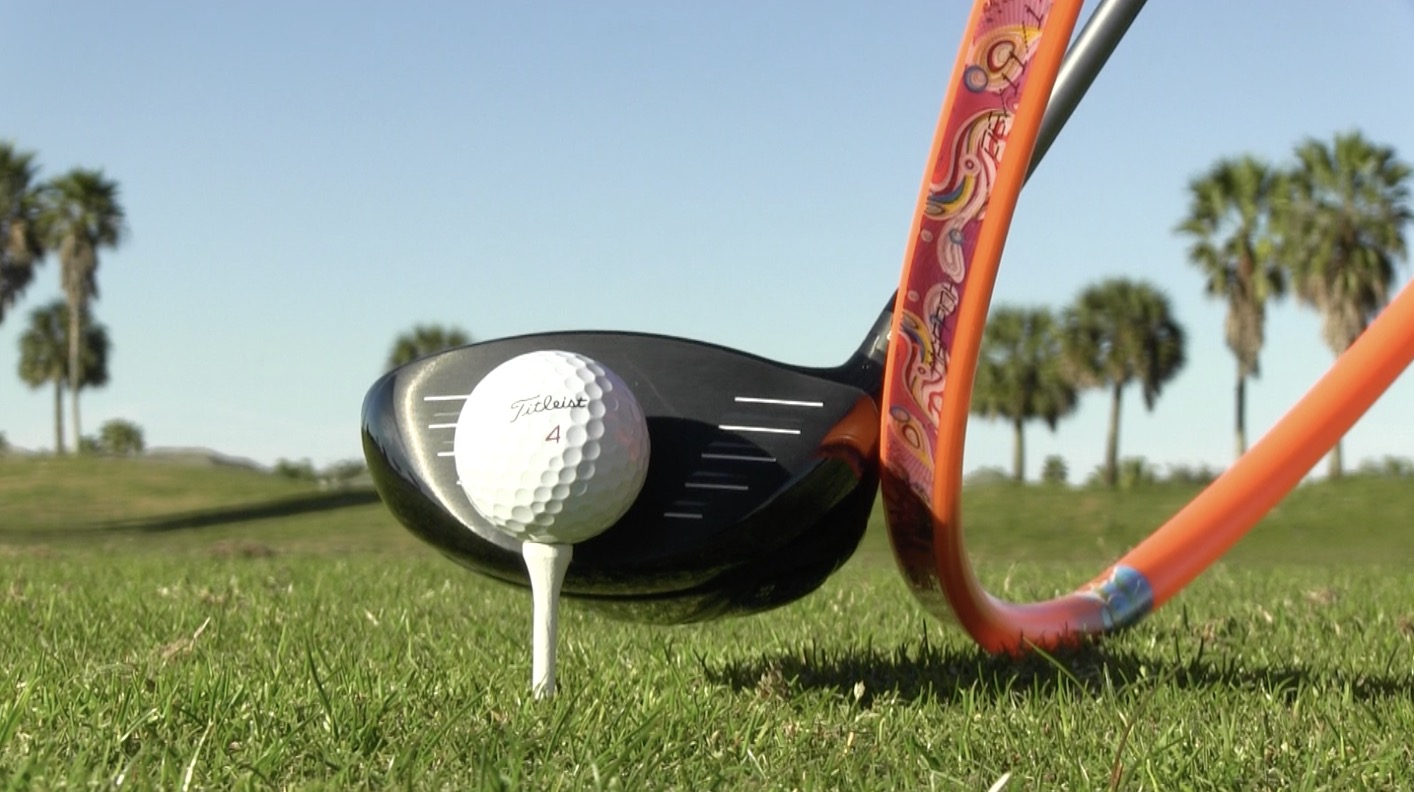
- When you take your golf stance with irons, you probably stand with your feet square to the target.
- For your driver shots, I want you to try stepping your lead foot just a tiny bit forward toward the golf ball. Don’t go for a huge change, just a small adjustment.
- Now, with this little adjustment with your feet, you are directing your swing path slightly to the right of the target. This allows for the golf club to come in contact with the ball at an upward angle yet still provide the desired in-to-out swing path.
Clubhead
I just taught this to one of my tour professionals this past week. It’s just a magic move that works every single time. While it might sound too simple to be a real solution, try it for yourself. See if it works.
When you take your setup, keep the clubhead slightly elevated off the ground directly behind the golf ball. Also, make sure the clubhead is square to the target line, not your feet. This is key! The clubface may look a little closed to your eye. However, it is still square to your intended target and will produce that high draw ball flight we desire.
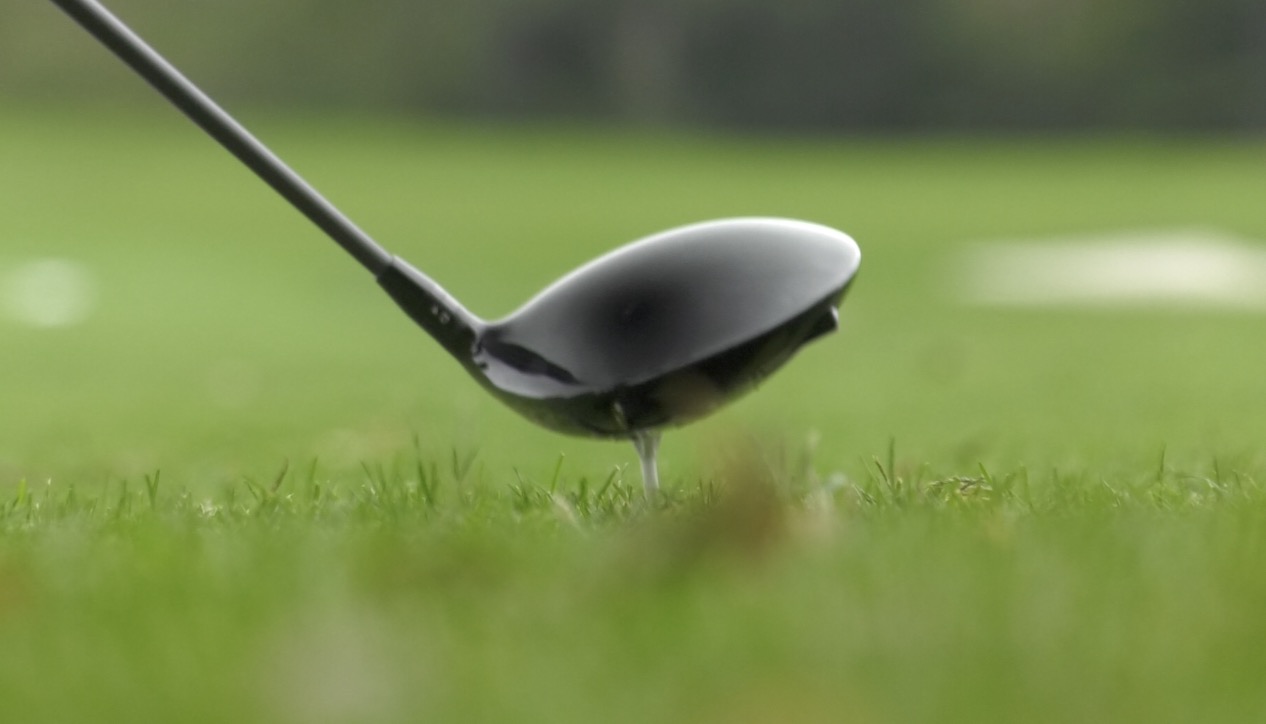
Related Questions
Why Can I Hit My Irons Straight But Slice My Driver?
You likely slice your driver because the golf shaft is much longer, creating more opportunities for the clubface to get out of position compared to your irons where the club shafts are much shorter. The timing and swing path requirements differ dramatically between irons and drivers.
Why Am I Slicing My Driver So Badly?
The main culprit is likely an outside-to-in club path through impact, causing the clubface to stay open, putting side spin on the golf ball. This swing flaw is exaggerated by the driver due to the longer length.
How Do I Adjust My Driver to Stop Slicing?
To stop slicing the driver, focus on squaring the clubface at impact and swinging more from the inside on your downswing. Making setup adjustments like aiming slightly right of the target line while keeping the clubface square to the target line can help encourage an in-to-out swing path with a square clubface producing a nice high draw ball flight.
Conclusion
With a few setup and swing adjustments tailored to the unique driver swing, you can confidently attack par 4s and 5s as you put an end to slicing your driver once and for all. Embracing the stark differences between driver and iron swings enhances your knowledge and increases your ability to find consistency from the tee box.
And if you’re ready to start adding some speed to your golf game, check out our Free Counter Backswing Sequence Series. It can add 20 yards or more in 20 minutes or less!


I noticed in one of your videos that you were using a pyramid putter. Is this your putter of choice? Would like your review of this putter.
David, good question. We do like the Pyramid putter…keep in mind putters are very individual and you need to find the one that works best for you.
Great video. Couldn’t believe it straightened my slice out right away. Thanks!
Todd,
I am senior golfer (72). I have a 10.5 draw model Launcher HB Turbo . He talk about aiming to the right. Is the swing path along the target lines? When setting up for swinging the driver, how do know if you are the correct distance from the ball?
Glad we could help Jay! Which tip did you find most helpful!
Peter, good question. Swing to the right of the target line while the clubface is pointed at the target. If you do just that, you will see a nice high draw!
How about a lesson for those of us who over draw (hook) the ball? I’m feeling left out.
Hi Todd, I’m receiving your emails for only a couple of weeks and really enjoy the tips. My biggest problem at the course is off the tee for my driver. I consistently top the ball when it’s teed up, nothing more frustrating when I can’t hit the ball past the ladies tee. Do you have any suggestions?
Werner,
Appreciate the kind words. We do our best to provide good solid information Here is a good video which will help https://youtu.be/Vm7m1v_bDt4
Russell,
Ask and you shall receive https://youtu.be/Tex0pm1A31s
Thanks Todd, I’ll check it out on the range. Mid round I’m finding balls tending towards hooking. Hopefully your tip will help!
Thanks for commenting Russell, be sure to let us know how it goes!
Love the series. One suggestion – Can you slo motion after the golf swing by Todd? This would give me and others an opportunity to study a little better. Thanks
Good idea…we will pass the information forward. Thanks!
Good morning Todd and thank you for your tips. After my rotator cuff surgery last year I wanted to start a new swing, That’s when I found USGolfTV and your lessons have helped greatly.
Toward the end of the video on how to change your driver slice to a draw you said to move the left foot slightly forward and aim the shoulders slightly right. Does this mean to swing toward the right or should I swing toward the target line with the club face also aimed at the target?
Thank you.
Mike,
Great to see you back playing. You want the clubface pointing at the target while swinging the club along the toe line. Make sense?
Thanks for your videos, I’ve learned more from them than from 50yrs of trial and error struggling
Could you please speak to grip thickness (diameter) how that might effect performance
Armin,
Thanks for the kind words. Our team does it’s best to provide good solid information. We will make a note to discuss grip thickness in one of our videos. In general, the thicker the grip the more prone to slicing you will be.
I think your last tip works because it puts the sweet spot in the right position for the swing. If you put the club down, the starting position for the swing is different and you have to correct the difference between the laid down and the hovering club during the swing. As the driver does not touch the ground during the swing you need to correct that. It’s not much but still enough to miss the sweet spot on the face. For players this is another source of error that they must be aware of and which then often leads to heely shots and those favoring the slice again.
Thanks for the very insightful articles and videos!
Peter, you are spot on. Great post.
Been playing golf for more than 60 years and have seen about every type of swing you could imagine. If beauty and form and perfect hairdos were required for competitive golf, there would not be very many golfers. To me the key to good competitive golf is repetition. If you know you are going to slice the tee shot every time 20 yards off the fairway, aim 20 yards to the left. If you are a wristy putter, get good at it with more practice. Jim Furyk should not be playing with his ugly swing, but he knows where it’s going with that swing. What about waggles? Some of them are made-for-TV blooper’s reels. The bigger problem with most amateurs, is they watch the successful pros and try to emulate their style. Won’t work. Do your own thing repetitively until it is predictable. Just sayin’ ….. BTW, for most, golf is a way to get some exercise in the great outdoors, in a manicured environment, with the guys whose company you enjoy. Let’s not complicate it.
Roy,
You make solid points. In the end it is about results, not looks. Thanks for adding to the conversation.
String grip or neutral??
We prefer a neutral to slightly strong grip for most our players.